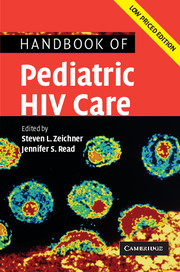Book contents
- Frontmatter
- Contents
- List of contributors
- List of abbreviations
- Foreword
- Preface
- Part I Scientific basis of pediatric HIV care
- Part II General issues in the care of pediatric HIV patients
- Part III Antiretroviral therapy
- Part IV Clinical manifestations of HIV infection in children
- 18 Cutaneous diseases
- 19 Neurologic problems
- 20 Ophthalmic problems
- 21 Oral health and dental problems
- 22 Otitis media and sinusitis
- 23 Cardiac problems
- 24 Pulmonary problems
- 25 Hematologic problems
- 26 Gastrointestinal disorders
- 27 Renal disease
- 28 Endocrine disorders
- 29 Neoplastic disease in pediatric HIV infection
- Part V Infectious problems in pediatric HIV disease
- Part VI Medical, social, and legal issues
- Appendix 1 Formulary of antiretroviral agents
- Appendix 2 National Institutes of Health sponsored clinical trials for pediatric HIV disease
- Appendix 3 Selected HIV-related internet resources
- Appendix 4 Selected legal resources for HIV-infected children
- Index
- References
19 - Neurologic problems
Published online by Cambridge University Press: 23 December 2009
- Frontmatter
- Contents
- List of contributors
- List of abbreviations
- Foreword
- Preface
- Part I Scientific basis of pediatric HIV care
- Part II General issues in the care of pediatric HIV patients
- Part III Antiretroviral therapy
- Part IV Clinical manifestations of HIV infection in children
- 18 Cutaneous diseases
- 19 Neurologic problems
- 20 Ophthalmic problems
- 21 Oral health and dental problems
- 22 Otitis media and sinusitis
- 23 Cardiac problems
- 24 Pulmonary problems
- 25 Hematologic problems
- 26 Gastrointestinal disorders
- 27 Renal disease
- 28 Endocrine disorders
- 29 Neoplastic disease in pediatric HIV infection
- Part V Infectious problems in pediatric HIV disease
- Part VI Medical, social, and legal issues
- Appendix 1 Formulary of antiretroviral agents
- Appendix 2 National Institutes of Health sponsored clinical trials for pediatric HIV disease
- Appendix 3 Selected HIV-related internet resources
- Appendix 4 Selected legal resources for HIV-infected children
- Index
- References
Summary
Introduction
Neurodevelopmental abnormalities have been a well-known and frequent complication of pediatric HIV infection, causing significant morbidity and mortality [1]. However, significant progress has been made in the treatment of pediatric HIV disease, changing the prevalence and natural history of neurological complications.
Central nervous system (CNS) manifestations of HIV disease can be subdivided into two main groups: (a) those indirectly related to the effects of HIV on the brain, such as CNS opportunistic infections (OIs), malignancies, and cerebrovascular disease, and (b) those directly related to HIV brain infection.
Peripheral nervous system (PNS) abnormalities occur relatively frequently in adult HIV-infected patients and are usually related to antiretroviral therapy, HIV disease, or OIs [2]. Although much less common in infants and children, neuropathies and myopathies occur, with similar etiologies [3].
Secondary CNS disorders
Opportunistic infections of the CNS
Children with HIV disease have fewer problems with CNS OIs compared with adults, probably because OIs represent reactivation of previous, relatively asymptomatic infections. CNS OIs can present significant problems in children; their incidence may increase because children with HIV disease are living longer. Generally, OIs are seen in patients with severe immunocompromise (age-corrected CD4+ lymphocyte counts less than 200 cells/μl), and in infants and younger children due to congenital infection.
The most common CNS OI in chlidren is cytomegalovirus (CMV) infection, which may present as a subacute or chronic encephalitis/ventriculitis, an acute ascending radiculomyelitis, or as an acute or subacute neuritis [4, 5] (see also Chapter 34).
- Type
- Chapter
- Information
- Handbook of Pediatric HIV Care , pp. 503 - 519Publisher: Cambridge University PressPrint publication year: 2006



